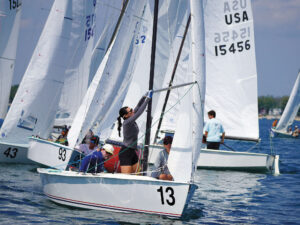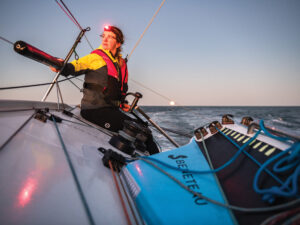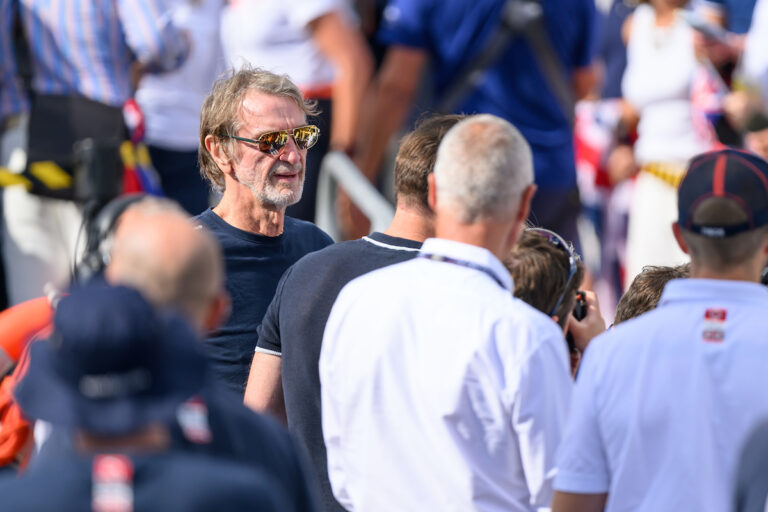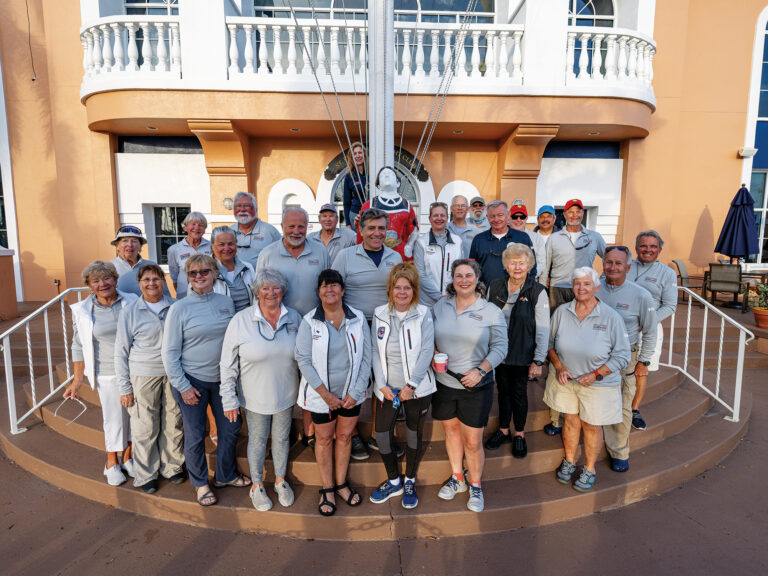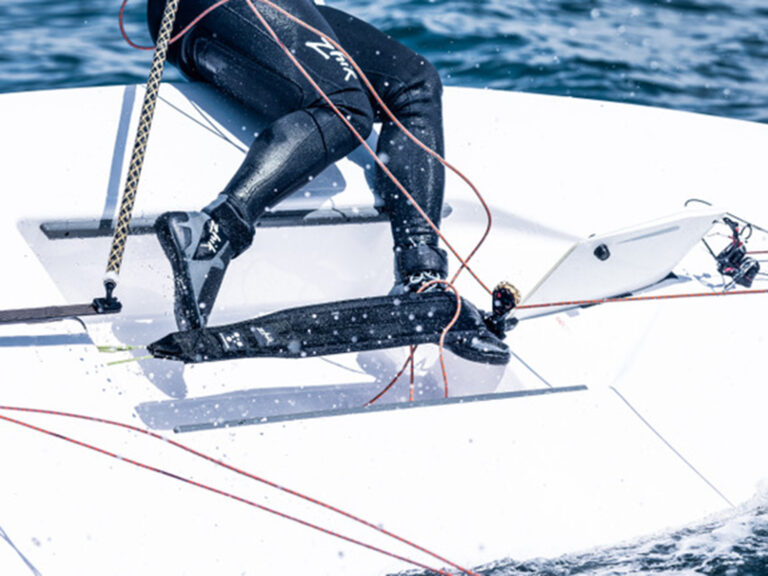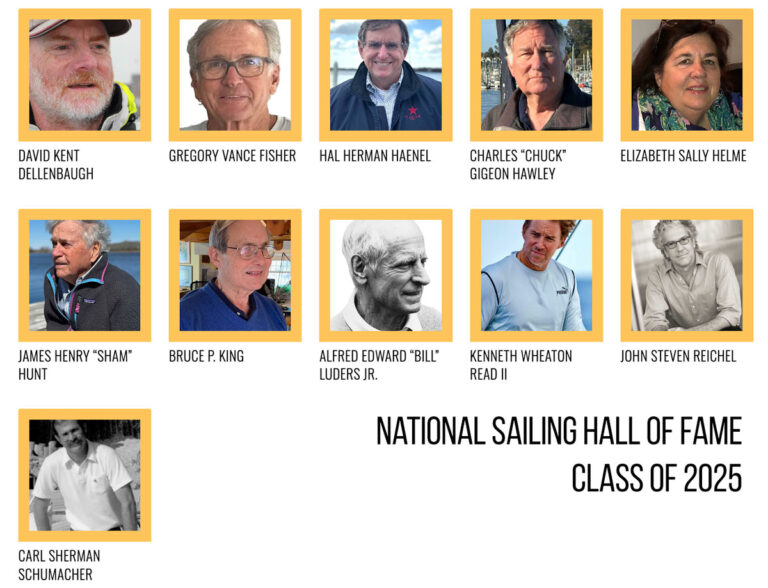There’s an old saying that sailing is a sport for kids from ages 8 to 80. Eight years old is still about the right age for beginning sailors, but at the more senior end of the spectrum, the limit has been busted wide open. Last fall the New York YC honored its 100 senior members at a dinner; most of them are well into their 80s and 90s, and still setting sail in one way or another. They’re unpretentious, and I’m sure their consistent love for the sport has helped them remain down to earth and young at heart. ¶ At the dinner, Walter Cronkite, 89, poked fun at himself, describing how proud he was to become a NYYC member in 1963, only to be scolded that summer for flying the club burgee upside down. He also recalled the night in 1983 he was scheduled to give a library talk; that ended up being the same day the America’s Cup was lost to Australia. Cronkite said that incident obviously ended any chance he might’ve had of becoming a flag officer of the club. The evening also made me think about how active so many senior people are as sailors and supporters of the sport. Olin Stephens, 97, may be the leading example; he’s still thinking about yacht design, commentating on issues, working on handicapping, and attending events internationally. After joining the NYYC in 1930, he helped the club defend the America’s Cup eight times between 1937 and 1980. In the club yearbook, he’s listed No. 1 (most senior member). When his train from Vermont was delayed on the night of the dinner, he walked into the Club’s Model Room to a standing ovation. A remarkable senior sailor in my hometown, Annapolis, is Bob McNitt, 90, a retired U.S. Navy admiral. He graduated from the Naval Academy in 1938, the same year he competed in his first Bermuda Race. He later earned a master’s in mechanical engineering at MIT. For the past 11 years I’ve served on the Naval Academy’s Fales Committee, which advises the Superintendent on waterfront activities, and Admiral McNitt attends every meeting. When he speaks he chooses his words carefully and everyone listens because no one else has his range of experience. In 1996 McNitt published Sailing at the U.S. Naval Academy, a meticulously researched book, which is a must-read for anyone running a yacht club or waterfront facility. So much for retirement-he started that book at age 80. McNitt is often seen sailing his small Dyer dinghy on the creeks of Annapolis. “Getting in and out isn’t as easy as it used to be,” he says, “but it’s wonderful to be on the water. I don’t pay so much attention to the boat. I like watching Blue Herons land on the water, ducks swimming, or the leaves changing color.” He served as dean of admissions at the Naval Academy for 12 years, is a member of the U.S. Naval Academy Sailing Foundation, and his writings appear in the Encyclopedia Britannica. His advice for young sailors is to, “Enjoy the day, enjoy the minutes.” Dr. Stuart Walker, 83, is another stalwart who remains one of the most active racers on the Chesapeake Bay. On New Year’s Day this year he raced his Soling in a regatta that he has only missed twice since 1952. At present he’s working on his 10th book, which discusses the complex topic of how a person’s genetic background governs competitive ability. He finds that we all suffer from compulsions that induce us to do the wrong thing at the wrong time. I recently asked him if one’s competitive instincts change as we get older. “Absolutely,” he says. “I think I’ve gained ‘acquired courage.’ I’ve always been anxious and fearful of competition. Once I get into it I feel calm. I always worried about sticking my neck out and looking like an idiot, but over the years I’ve become more courageous.” Walker has written regularly for Sailing World since 1962. He competed on the U.S. Olympic team in 1968 as a crewmember for Gardner Cox in the 5.5-Meter class. “That’s where I first met Paul Elvstrom,” he says. “He convinced me to sail a Soling and I’ve been doing it ever since.” Does sailing keep him youthful? He laughs and says, “I think we don’t realize in a sense how much physical involvement there is. We think we just sit there [on the boat]. Well, you’re sitting there, but your muscles are tense; you’re holding yourself in a certain position to add to the heel or reduce the heel. Your body is functional even though it is only sitting.” I asked him if he had become an elder statesman, to which he replied, “Well of course. But I’m still the guy they want to beat.” Ed du Moulin, 91, is also working on a new book that he says will cover 80 years of sailing, 47 years on Wall Street, four years of service during World War II, and a lot of “crazy” incidents in his life. In 2001 du Moulin’s recollections of seven America’s Cup campaigns were published by the Herreshoff Marine Museum in The America’s Cup and Me, an enjoyable read. Du Moulin’s inspiration for participating in the Cup started when he observed Ranger defeating Endeavour II in 1937. After retiring from a successful career on Wall Street, he started a new one as manager for seven different America’s Cup teams. Recently he’s been slowed by illness but is looking forward to day sailing this summer. “I’ve enjoyed all my boats over the years, but I always enjoy trying to find the next boat. I’m looking at an Alerion 28.” Du Moulin has always had a winning diplomatic manner and has often brought adversaries together. I recall being on an America’s Cup team that was eliminated, and even though Ed was part of another team, he and Fritz Jewett had the courage and good sportsmanship to thank our crew for pushing their team so hard. His extraordinary class has served many as a good example. Emotions ran high in Newport, R.I., when the New York YC lost the America’s Cup in 1983. At the prizegiving the next morning, a few thousand people were understandably anxious about handing over of the trophy. Bob Stone, now 83, was the club’s commodore then, and I’ll always remember how his sense of humor and graceful manner made the historic ceremony a great sporting moment. Australia II’s designer, Ben Lexcen, had told the press before the series that if he ever got his hands on the Cup, he was going to crush it. Commodore Stone got some help from the Newport police, finding an old Plymouth hubcap and crumpling it. At the prizegiving, Stone first handed Lexcen the hubcap and told him now he no longer need to smash up the America’s Cup. After putting both the Australians and Americans at ease, Stone laid his hand on Lexcen’s shoulder and said, “Please take care of the Cup, will you?” Commodore Stone, as many still call him, has served on countless corporate boards and as a longtime fellow of Harvard College. He still races and cruises his 69-foot Arcadia and is scheduled to skipper it in his 25th consecutive Bermuda Race in June. At the NYYC Senior Members Dinner, where I recalled that momentous day in Newport, Stone addressed the dinner guests, reflecting on his years of sailing, and pointing out that the best part was the many special people he’d met and sailed with. In particular, he said Percy Chubb, Henry Morgan, and George Hinman were all role models. Everyone in the audience visibly brightened as he spoke. I think we all began recalling our own mentors, realizing that many of our best friends in life all share the same passion. There’s a common denominator I learned that night about the senior sailors: They cherish their time on the water and they do anything they can to help and inspire others to do the same.
